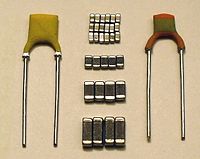
Photo from wikipedia
Occurrence of high frequency emission due to increasing use of power electronic based equipment challenges the functioning of equipment, e.g., malfunctions of equipment, audible noise or performance/lifetime degradation of dc-link… Click to show full abstract
Occurrence of high frequency emission due to increasing use of power electronic based equipment challenges the functioning of equipment, e.g., malfunctions of equipment, audible noise or performance/lifetime degradation of dc-link capacitor. When subjected to a high frequency voltage distortion, an ac–dc converter draws intermittent current of the same frequency, this is referred to as “intermittent conduction.” In this article, a link between intermittent conduction and dc-link capacitor current has, for the first time, been constituted through a mathematical expression. Based on this, a model that can quantify the impacts on dc-link capacitor and calculate maximum allowed voltage in the frequency range of 2–150 kHz, so called “supraharmonics (SHs),” has been proposed for avoiding degradations. Besides modeling, a testing technique is implemented where maximum allowed voltage can be identified for an equipment under test. The result shows that dc-link capacitor's stress can be managed under the SHs if maximum SH voltages are respected. The proposed model gives a better understanding of SH impacts on dc-link capacitor and the mechanisms behind. This article has been limited to equipment that draws input current lower than 16 A as they exhibit more nonlinear characteristic and longer zero crossing, which results in intermittent conduction.
Journal Title: IEEE Transactions on Power Electronics
Year Published: 2022
Link to full text (if available)
Share on Social Media: Sign Up to like & get
recommendations!